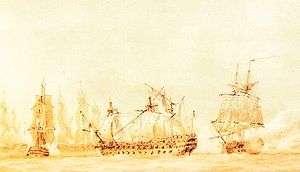HMS Inconstant (1783)
 HMS Inconstant (left) fighting Ça Ira | |
| History | |
|---|---|
| Name: | HMS Inconstant |
| Ordered: | 8 December 1781 |
| Builder: | William Barnard, Deptford |
| Laid down: | December 1782 |
| Launched: | 28 October 1783 |
| Honours and awards: | Naval General Service Medal with clasp "Egypt"[1] |
| Fate: | Broken up in November 1817 |
| General characteristics | |
| Class and type: | 36-gun Perseverance class fifth rate |
| Tons burthen: | 890 (bm) |
| Length: | 137 ft 9 in (41.99 m) |
| Beam: | 38 ft 3 in (11.66 m) |
| Draught: | 9 ft 6 in (2.90 m) |
| Propulsion: | Sails |
| Sail plan: | Full rigged ship |
| Complement: | 260 (270 from 25 April 1780) |
| Armament: |
|
HMS Inconstant was a 36-gun Perseverance class fifth rate frigate of the Royal Navy. She had a successful career serving in the French Revolutionary and Napoleonic Wars, capturing three French warships during the French Revolutionary naval campaigns, the Curieux, the Unité, and the former British ship HMS Speedy.[2]
Construction and commissioning
Inconstant was ordered on 8 December 1781 and laid down at the yards of William Barnard, Deptford, in December 1782. She was launched on 28 October 1783, and was immediately fitted out for ordinary, a process completed by 22 March 1784. She was moved to Woolwich in October 1788 and there fitted out for sea between June and November 1790. She had cost a total of £16,226.0.1d (including the work to fit her for ordinary, with a further £6,627 spent in 1790 to prepare her for sea.[2]
Career
Inconstant was commissioned in August 1790 under Captain George Wilson. Wilson commanded her for just over a year before she was paid off in September 1791.
French Revolutionary wars
Inconstant returned to Woolwich and was fitted out again between January and February 1793 at a cost of £7,239. She was recommissioned under Captain Augustus Montgomery and joined the fleet under Richard Howe. She sailed to the West Indies in April, and captured the 14-gun Curieux there on 3 June 1793.[2]
Inconstant returned to England in July that year, sailing again in November bound for Toulon to join Samuel Hood's fleet. She was briefly commanded by Captain George Cockburn in 1794, but he was succeeded by Thomas Fremantle in January 1795. Under Fremantle, and as part of the fleet under Admiral William Hotham, she fought against the 80-gun Ça Ira on 10 March 1795. The Ça Ira’s massive superiority in firepower soon forced Fremantle to fall back. As he did so, HMS Agamemnon, commanded by Captain Horatio Nelson, surged past to continue the fight.[3] This was a prelude to the Naval Battle of Genoa, fought over the next few days.
On 25 March Inconstant recaptured HMS Speedy from the French, and went on to form part of Nelson's squadron in August.[2] On 20 April 1796 she captured the French Unité. The Unité was taken into service as HMS Surprise. Inconstant was then present at the evacuation of Leghorn on 26 June 1796. After an active period in the Mediterranean, she was paid off in September 1797. She was refitted at Woolwich between March and June 1798, returning to service as a 20-gun troopship.[2] She was commanded by Commander Milham Ponsonby until being paid off in October 1799, after which she was refitted and recommissioned as a fifth rate under Commander John Ayscough. Inconstant was initially operating in the North Sea, before receiving orders to move to support operations in Egypt in 1801. Because Inconstant served in the navy's Egyptian campaign (8 March to 8 September 1801), her officers and crew qualified for the clasp "Egypt" to the Naval General Service Medal that the Admiralty authorised in 1850 for all surviving claimants.[Note 1]
She came under the command of captain Richard Byron in October 1802, but by December was under Captain Edward Dickson.[2]
Napoleonic Wars
Inconstant was fitted out as a troopship again in late 1803, and was present at the capture of Gorée in March 1804.[2] She was restored as a frigate between 1805 and 1806, and spent the period between 1806 and 1808 as the flagship of Vice-Admiral James Saumarez.[2] A large repair was carried out between 1808 and 1809, after which she sailed to the Cape of Good Hope. She was paid off in 1810, and refitted at Portsmouth. She recommissioned again in October that year, under the command of Captain John Quilliam, but by December command had passed to Captain Edward Owen.[2] Owen remained in command until 1812, being succeeded by Sir Edward Tucker. Tucker sailed Inconstant to South America, and in August 1815 she was serving as Captain James Lucas Yeo's flagship.[2]
Fate
HMS Inconstant was finally broken up at Portsmouth in November 1817.[2]
Notes and citations
- Notes
- Citations
- ↑ The London Gazette: no. 21077. pp. 791–792. 15 March 1850.
- 1 2 3 4 5 6 7 8 9 10 11 Winfield. British Warships. pp. Chap. 5; p. 200.
- ↑ Sugden. Dream of Glory. p. 546.
- ↑ The London Gazette: no. 17915. p. 633. 3 April 1823.
References
- Colledge, J. J.; Warlow, Ben (2006) [1969]. Ships of the Royal Navy: The Complete Record of all Fighting Ships of the Royal Navy (Rev. ed.). London: Chatham Publishing. ISBN 978-1-86176-281-8. OCLC 67375475.
- Winfield, Rif, British Warships of the Age of Sail 1714–1792: Design, Construction, Careers and Fates, pub Seaforth, 2007, ISBN 1-86176-295-X
- Sugden, John (2004). Nelson - A Dream of Glory. London: Jonathan Cape. ISBN 0-224-06097-X.